The Scottish Wildlife - Then and Now
Scotland is a special place for nature and wild species, but what is the story of the wildlife that lived and is still living there?
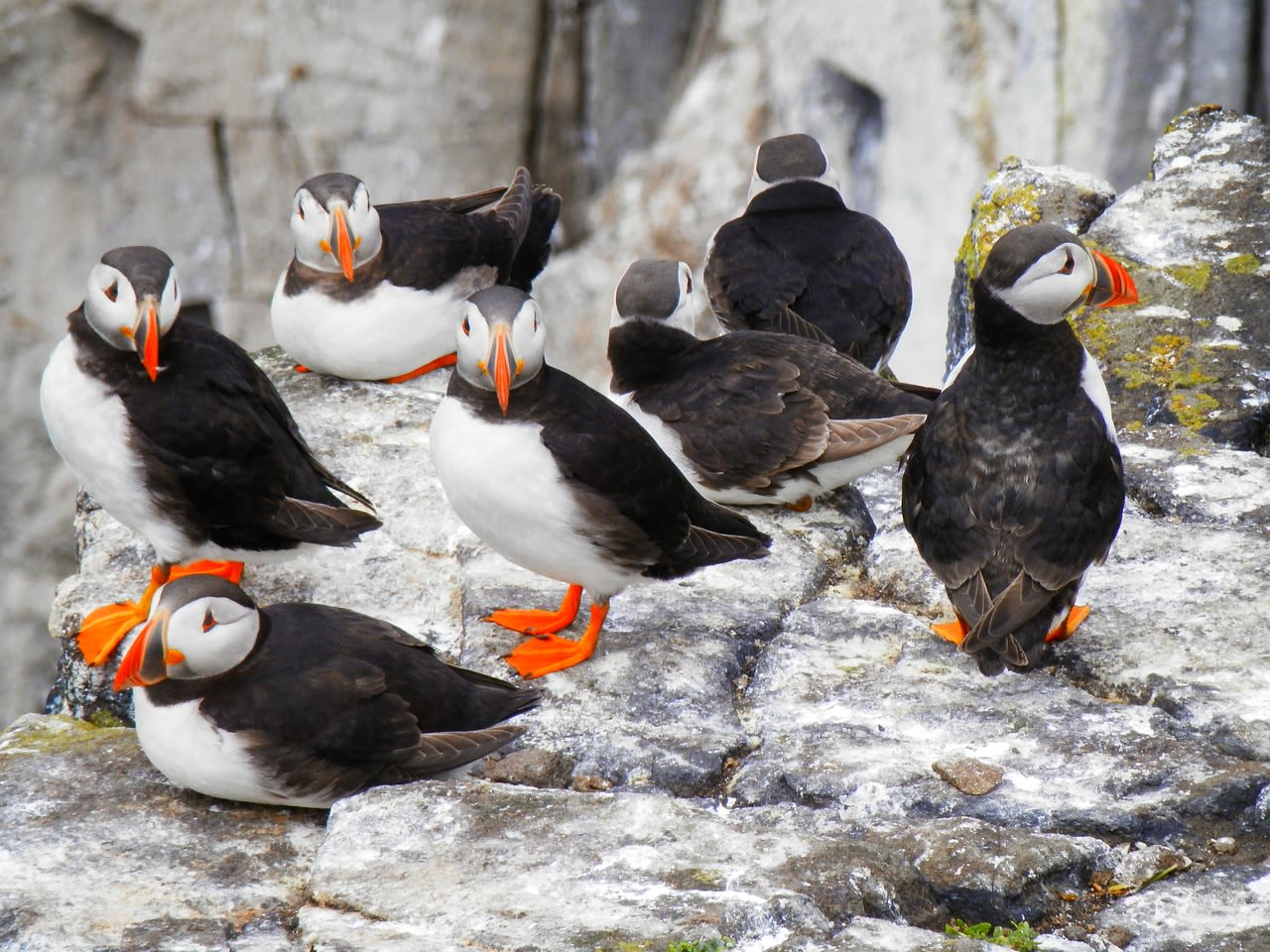
Scotland is a country of superlatives for wildlife. Here you will find out about the reintroduction plans for a top predator, about the species that used to rule the Scottish land, about how some passionate beekeepers saved a rare species of honey bees, and about the situation of the birds and how we can help them do better.
Roo Campbell, Mammals Advisor at Mammal Society, says: “An intact ecosystem is not just important for us, but actually the underpinning of our own society and civilization is a healthy ecosystem.”
Debates and controversy exist in Scotland for the reintroduction of a top predator, the lynx.

The main question is: is there enough suitable habitat to enable any reintroduction? Some people consider the reintroduction of the lynx as a way to help the ecosystem, while others argue that there might be a broader impact of such reintroduction.
The main question is: is there enough suitable habitat to enable any reintroduction? Some people consider the reintroduction of the lynx as a way to help the ecosystem, while others argue that there might be a broader impact of such reintroduction.
Roo Campbell explains: "Lynx prey on roe deer, roe deer are one of the species which impact forest regeneration, which imbalances the ecosystem.
Too many roe deer could have an impact on young tree saplings, then the forest isn’t regenerating and of course the forest, apart from being great for forest species, it’s also really important for climate change.
Lynxes are the predators that would prey on roe deer and could change their behaviour, so a settling effect, it might change roe deer behaviour so they may be spending less time in the forest because that’s where lynxes are hiding."

The lynx became extinct in Scotland after the 2nd or 3rd century, a reintroduction is planned.
The lynx became extinct in Scotland after the 2nd or 3rd century, a reintroduction is planned.
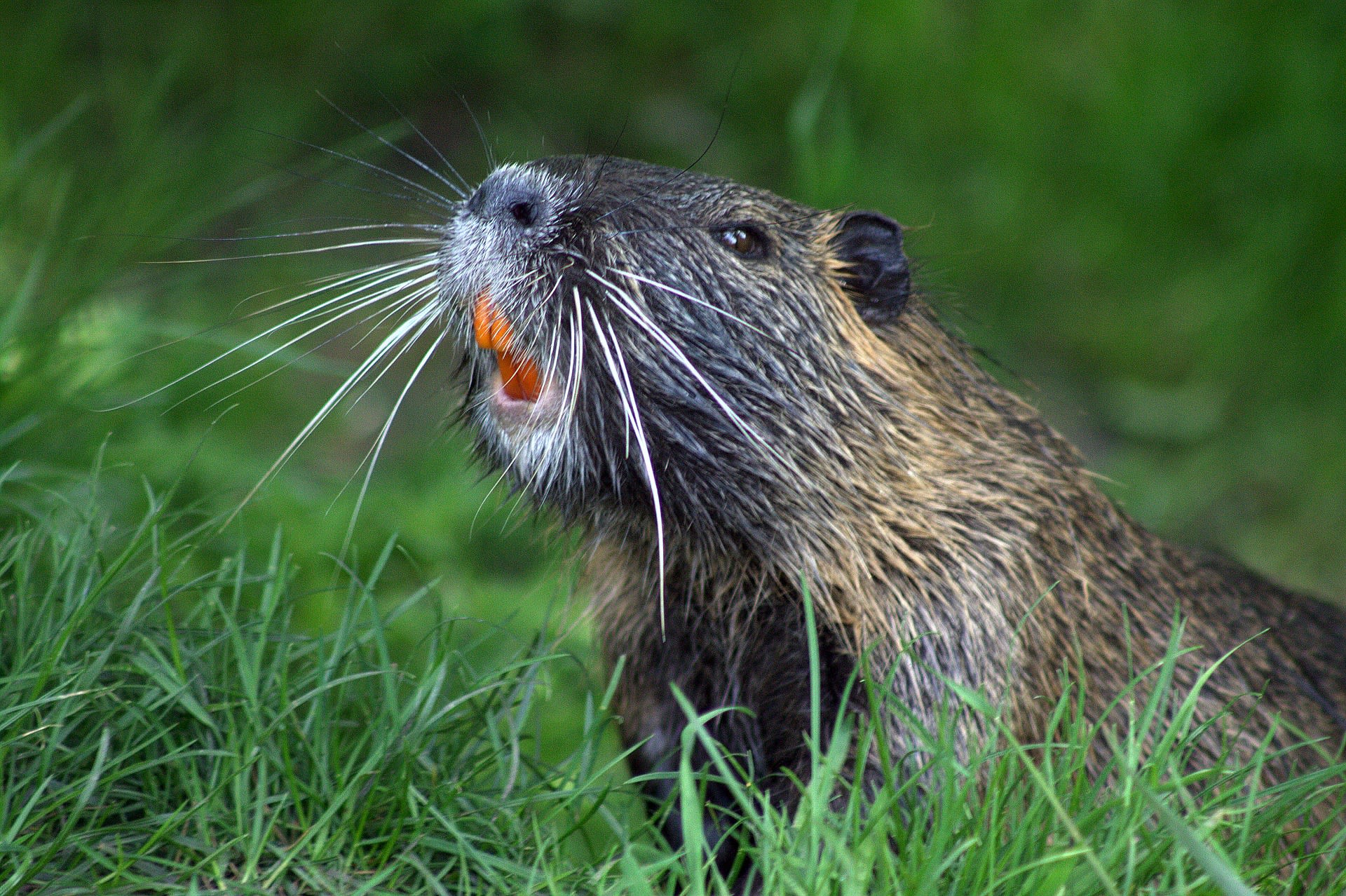
European beavers went extinct in Scotland in the 16th century. After two failed reintroduction, a new reintroduction proved to be successful. The Scottish Wildlife Trust was one of the lead partners in the Scottish Beaver Trial, which led to a decision by the Scottish Government in 2016 to allow beavers to remain in Scotland and be recognised as a native species. This moment marked the first successful reintroduction of a mammal in the UK.
European beavers went extinct in Scotland in the 16th century. After two failed reintroduction, a new reintroduction proved to be successful. The Scottish Wildlife Trust was one of the lead partners in the Scottish Beaver Trial, which led to a decision by the Scottish Government in 2016 to allow beavers to remain in Scotland and be recognised as a native species. This moment marked the first successful reintroduction of a mammal in the UK.
Tens of thousands of years ago, animals like the woolly rhinoceros, the arctic fox and the hairy mammoth used to roam Scotland. Here is an infographic with nine animals that went extinct in Scotland.

After the extinction of the big, woolly animals, the land was colonised by large predators like the brown bear, the wolves and the Northern lynx, which are now also extinct.

It is considered that the last wolf in Scotland was killed Officially by Sir Ewan Cameron of Lochiel in Lochaber in 1680. Other 'last wolves' were killed up until 1743. When a species becomes extinct it can disturb the balance of natural systems.
It is considered that the last wolf in Scotland was killed Officially by Sir Ewan Cameron of Lochiel in Lochaber in 1680. Other 'last wolves' were killed up until 1743. When a species becomes extinct it can disturb the balance of natural systems.
Roo Campbell says: “The ecosystem is a bit complex, but it’s not often really apparent the impact on lots of species, but generally the more species the ecosystem has, the more stability it has. "
Here is an infographic with species that went extinct and then returned or are planned to return to Scotland.

When it comes to species being endangered, the reasons can be loss of habitat or lack of genetic variation. An endangered mammal in Scotland is the wildcat, the main threat to them is the hybridization with the feral cat. In this interactive image you will find an example of going the extra mile for helping wildlife:
Here is an infographic with 10 Scottish species that are at risk:

For more information on mammals and wildlife conservation and how you can contribute yourself, Here's the full interview with Roo Campbell:
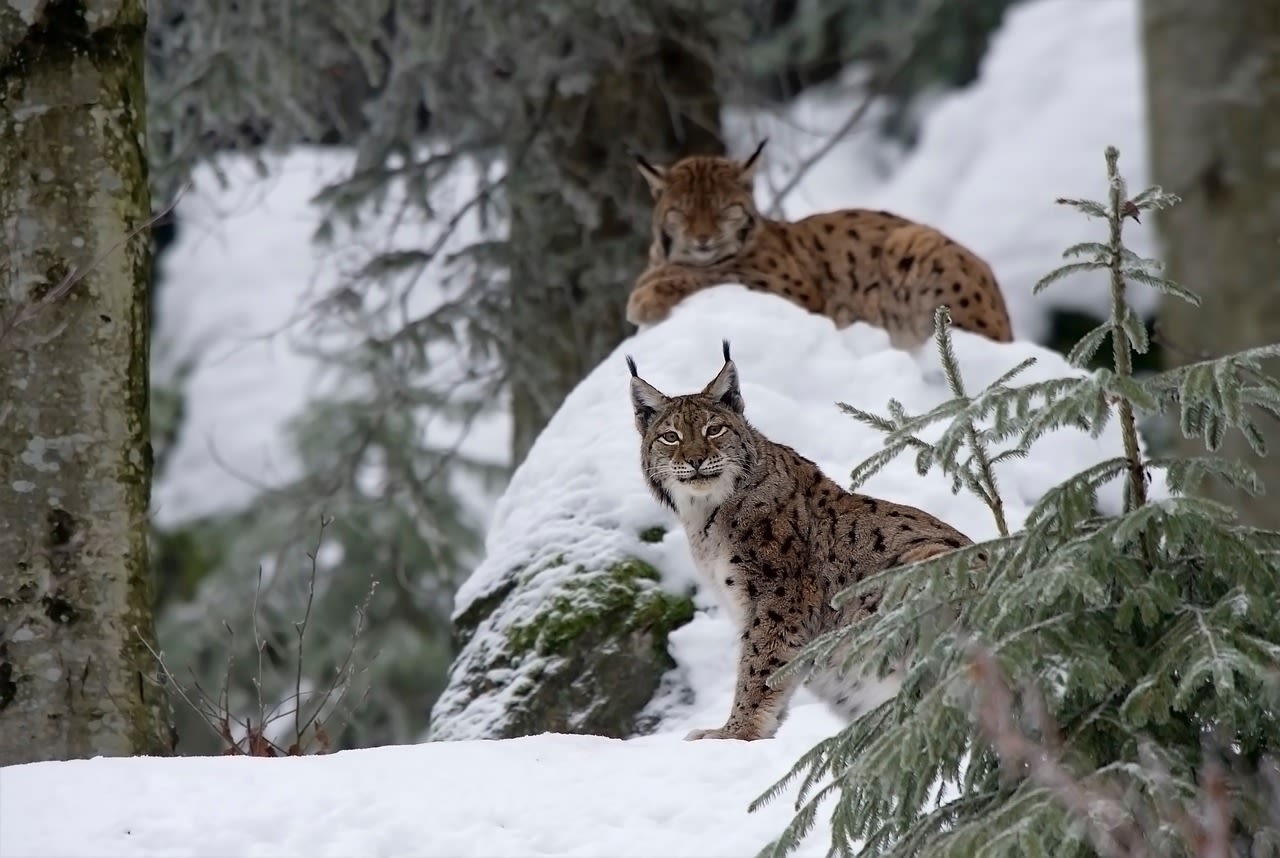

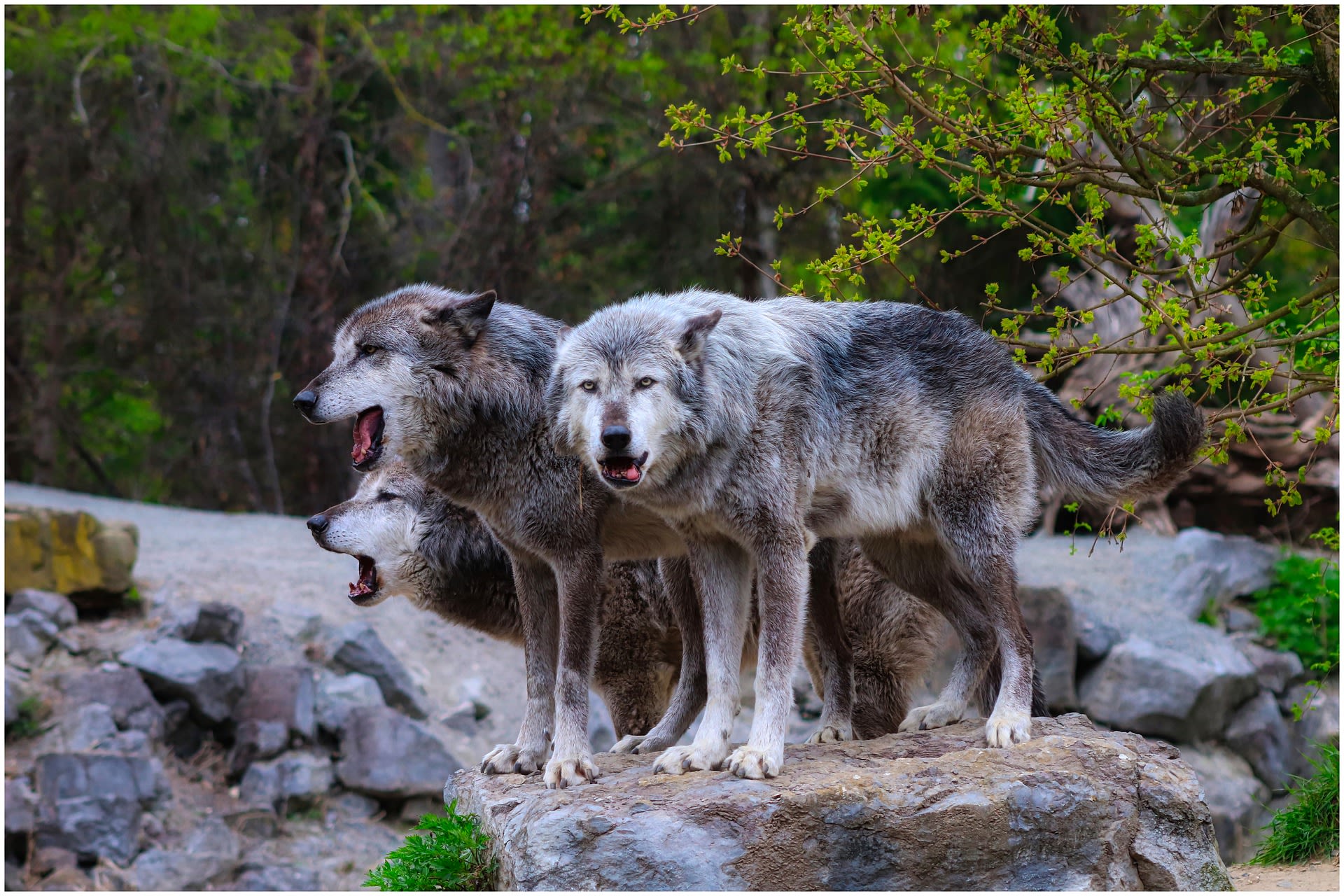
A very important Scottish native species, vital for the ecosystem is the Scottish Native Honey Bee. Dating back to the Ice Age, these thicker, darker bees are very rare and threatened mainly by cross-breeding with non-native honey bees. But it's not all bad news, as a group of loving beekeepers decided to help them by taking most of them from the wild and caring for them.
It started with a beekeeper named Andrew Abrahams from the Island of Colonsay, who in the 1980s took the best examples he could find into the island and started looking after them. After much effort from him, the Scottish Government acknowledged the Island as a reserve for the native bees, this was the first step towards saving this species.

Scottish Native Honey Bees Colony © Scottish Native Honey Bee Society
Scottish Native Honey Bees Colony © Scottish Native Honey Bee Society
Later, a group of beekeepers created an SCIO charity, the Scottish Native Honey Bee Society, aiming to find and take care of as many of the Scottish honey bees as possible. Now, maybe you're wondering, how can someone take bees from the wild and build managed colonies?
Gavin Ramsay, Chairman of SNHBS explains: "It's mostly by asking beekeepers what they have, and then check again, and then if there's a further stage to all this when we arrive at some that look quite good, we are then hoping that those beekeepers will cooperate with us by allowing us to raise new queens from what they have.
So we can go into the hive and take a frame of bees and lift the larvae and put them into special cells in another colony that doesn't have a queen, and we can get that colony to make a set of new queens for us, and then we can use these queens to head other colonies."
You can find out more about the beautiful plan of the Society for the native bees in this interview:
Members of SNHBS also plan to build their colonies so they can be able to repopulate certain areas with native bees. If you're wondering how you can identify a native bee, this infographic will help you with that:

Information from: Scottish Native Honey Bee Society - Identifying Native Honey Bees
Information from: Scottish Native Honey Bee Society - Identifying Native Honey Bees

Scottish Native Honey Bee © Scottish Native Honey Bee Society
Scottish Native Honey Bee © Scottish Native Honey Bee Society

Searching for the Queen © Scottish Native Honey Bee Society
Searching for the Queen © Scottish Native Honey Bee Society

Scottish Native Honey Bees with their Queen © Scottish Native Honey Bee Society
Scottish Native Honey Bees with their Queen © Scottish Native Honey Bee Society
The number of birds in Scotland is dramatically changing, with many species showing a worrying decline and others enjoying an increase.
David Douglas, RSPB Scotland Principal Conservation Scientist said: “It’s really concerning that some of the UK’s bird species that Scotland is vitally important for, such as curlews and Arctic skuas, have experienced such worrying long-term declines. This means conservation efforts here are absolutely vital to these birds.
Further human impact is evident in the rising number of cuckoos in Scotland. Once more common in England, numbers there are in decline due to changes in land management and usage.”
The report reveals that Scotland’s birds continue to show mixed fortunes. If you want to understand more about the state of the Scottish birds, here's an interactive image for you:
Ben Darvill, BTO Scotland Development and Engagement Manager said: “Volunteers play an essential role in bird monitoring in the UK, by donating their time, energy and expertise. The data they collect are vital for conservation, tracking changes, policy development and informed decision-making."
Surveys have been conducted in Scotland to determine which birds have been decreasing and increasing in population, to present in better, here is an infographic with the Top 4 decreasing and increasing species of birds.
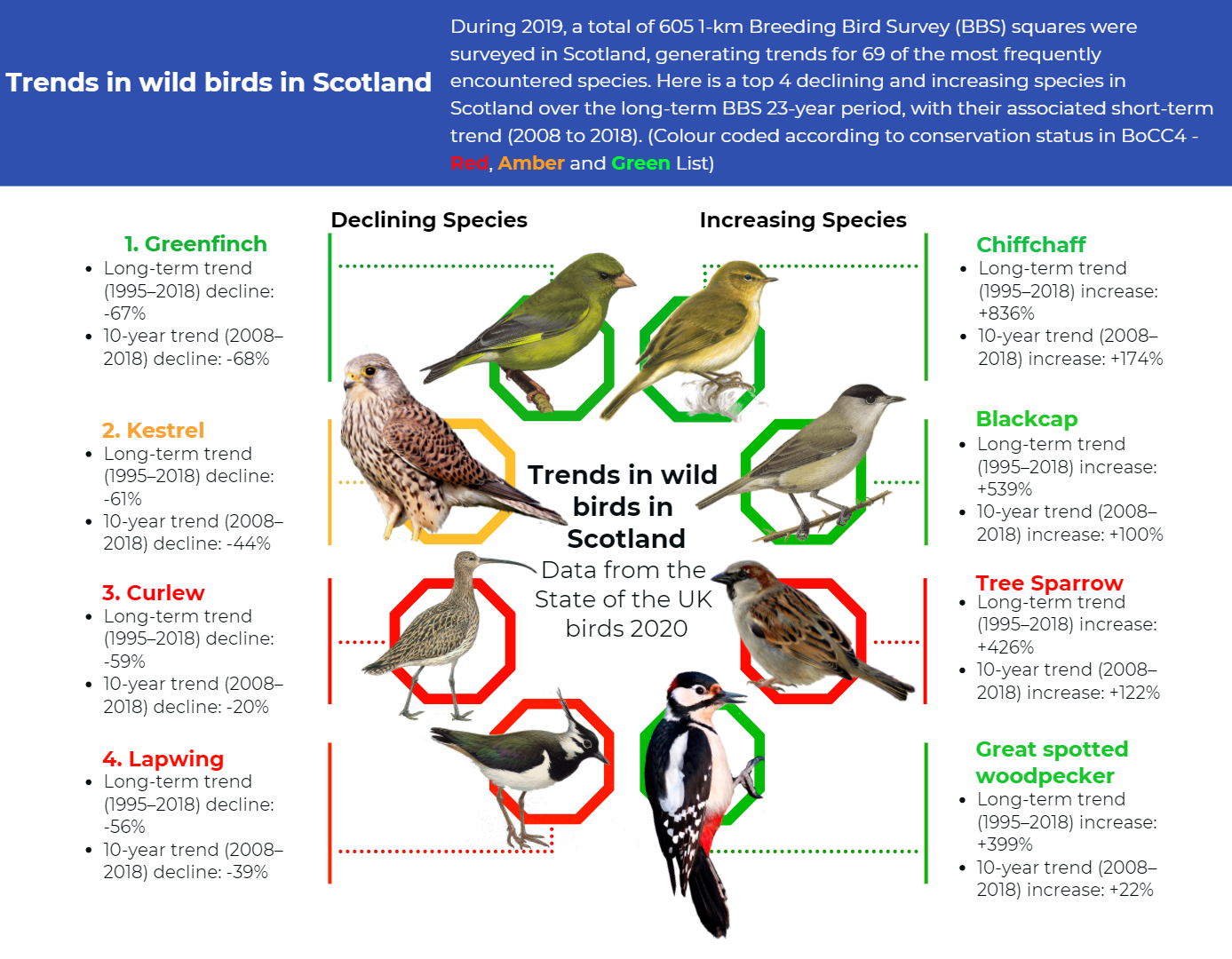
Data from the: State of the UK Birds 2020
Data from the: State of the UK Birds 2020
Andy Douse, NatureScot’s Ornithology Advisor said: “Many know that we are facing a climate emergency but not as many know that there is also a global nature crisis. Many iconic birds in Scotland, as well as other species, are suffering as a result.
We are already undertaking large scale habitat restoration projects across Scotland which will help these birds and help protect us from climate change. There are steps we can all take too – from your own garden to the thousands of people contributing to this vital survey programme.”
There are many ways to help the wildlife, from participating in surveys and choosing green energy, to feeding wildlife in your garden or building homes for nature. You can find more details about this at Mammal Society and Royal Society for the Protection of Birds.

Curlews are among the five most declining common and widespread birds in Scotland
Curlews are among the five most declining common and widespread birds in Scotland
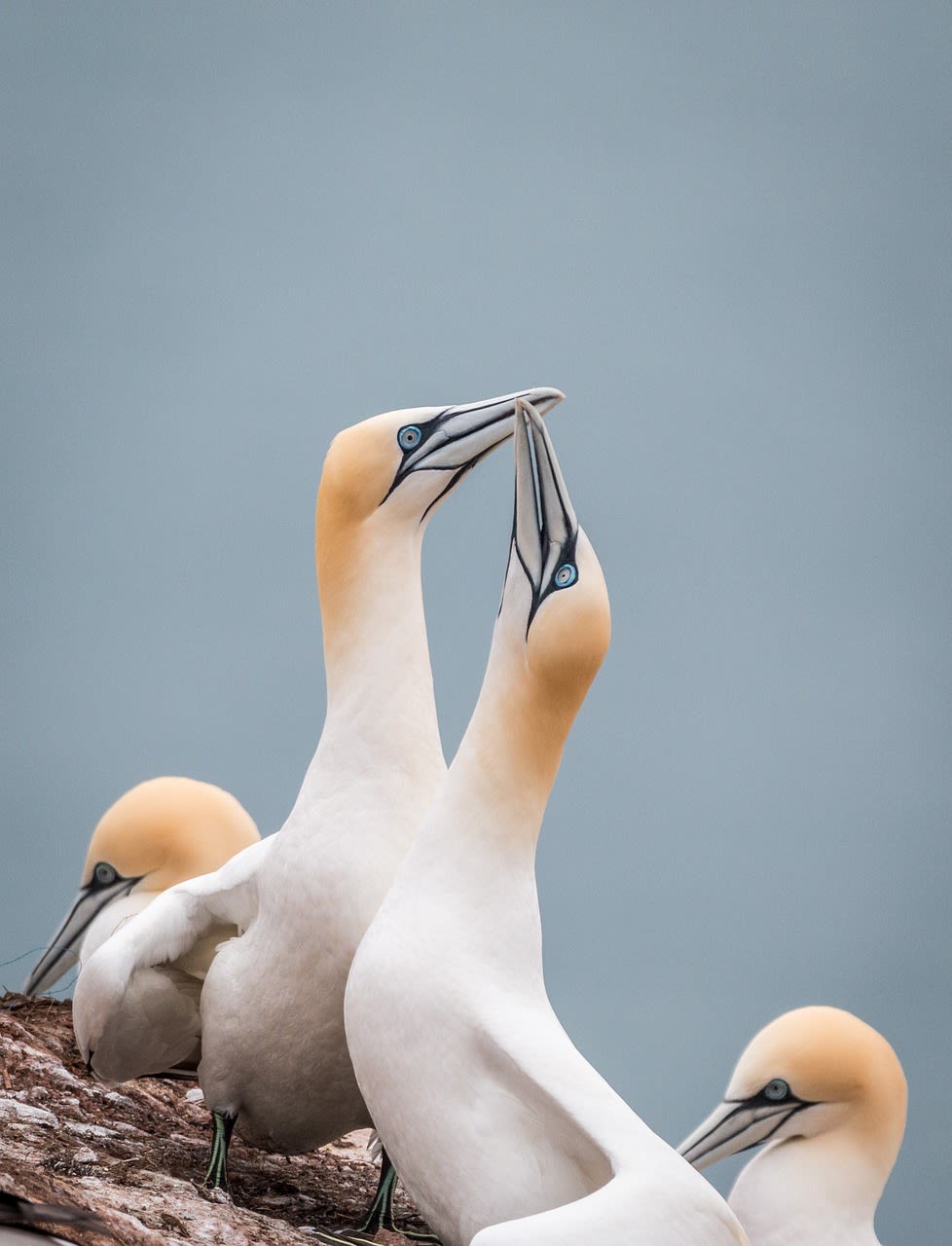
Gannet populations are doing well, with an increase in both numbers and range. Marwick Head in Orkney is one of a number of new and expanding gannet colonies which have contributed to the good fortune of this iconic species.
Gannet populations are doing well, with an increase in both numbers and range. Marwick Head in Orkney is one of a number of new and expanding gannet colonies which have contributed to the good fortune of this iconic species.
This article shows you how fantastic the Scottish Wildlife is and how you can help it live on. In this series of articles, Scotland: Then and Now, you will find out about the only fabric in the world that is guarded and protected by its own Act of Parliament and about how digital platforms were used to deliver the Highland Games in 2020 during the pandemic. You will also find out about the legends and the stories linked to six places in Edinburgh that you can still visit today, and how the Highland Dress and the bagpipes were adapted for the new fashion era:

